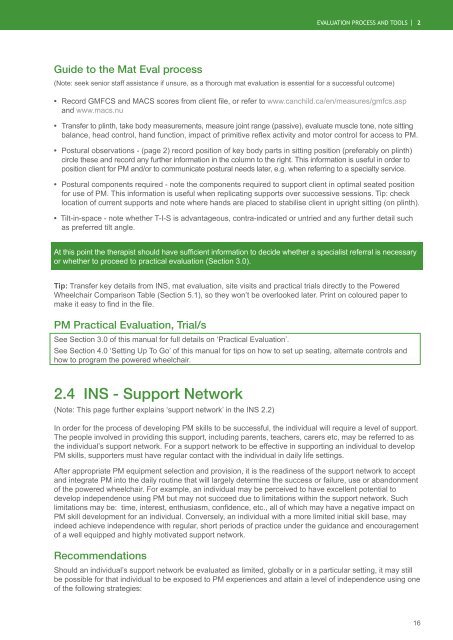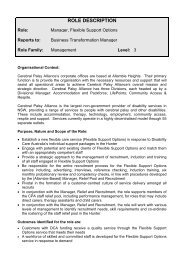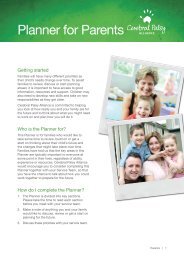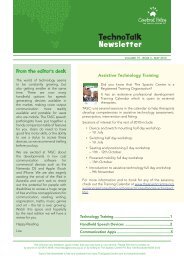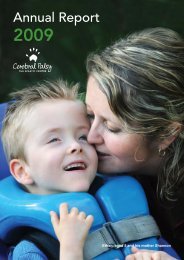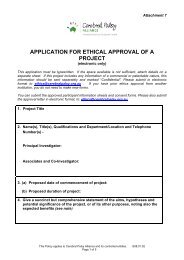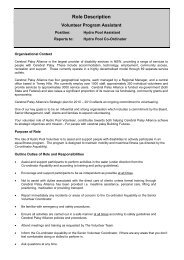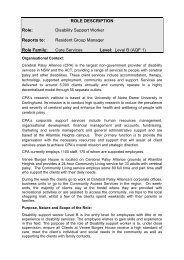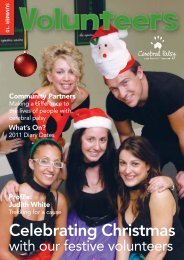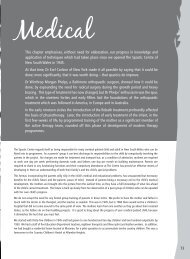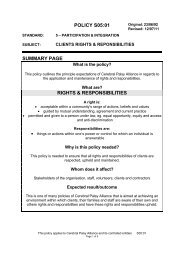Powered Mobility Manual - Cerebral Palsy Alliance
Powered Mobility Manual - Cerebral Palsy Alliance
Powered Mobility Manual - Cerebral Palsy Alliance
- No tags were found...
You also want an ePaper? Increase the reach of your titles
YUMPU automatically turns print PDFs into web optimized ePapers that Google loves.
evaluation process and tools | 2Guide to the Mat Eval process(Note: seek senior staff assistance if unsure, as a thorough mat evaluation is essential for a successful outcome)• Record GMFCS and MACS scores from client file, or refer to www.canchild.ca/en/measures/gmfcs.aspand www.macs.nu• Transfer to plinth, take body measurements, measure joint range (passive), evaluate muscle tone, note sittingbalance, head control, hand function, impact of primitive reflex activity and motor control for access to PM.• Postural observations - (page 2) record position of key body parts in sitting position (preferably on plinth)circle these and record any further information in the column to the right. This information is useful in order toposition client for PM and/or to communicate postural needs later, e.g. when referring to a specialty service.• Postural components required - note the components required to support client in optimal seated positionfor use of PM. This information is useful when replicating supports over successive sessions. Tip: checklocation of current supports and note where hands are placed to stabilise client in upright sitting (on plinth).• Tilt-in-space - note whether T-I-S is advantageous, contra-indicated or untried and any further detail suchas preferred tilt angle.At this point the therapist should have sufficient information to decide whether a specialist referral is necessaryor whether to proceed to practical evaluation (Section 3.0).Tip: Transfer key details from INS, mat evaluation, site visits and practical trials directly to the <strong>Powered</strong>Wheelchair Comparison Table (Section 5.1), so they won’t be overlooked later. Print on coloured paper tomake it easy to find in the file.PM Practical Evaluation, Trial/sSee Section 3.0 of this manual for full details on ‘Practical Evaluation’.See Section 4.0 ‘Setting Up To Go’ of this manual for tips on how to set up seating, alternate controls andhow to program the powered wheelchair.2.4 INS - Support Network(Note: This page further explains ‘support network’ in the INS 2.2)In order for the process of developing PM skills to be successful, the individual will require a level of support.The people involved in providing this support, including parents, teachers, carers etc, may be referred to asthe individual’s support network. For a support network to be effective in supporting an individual to developPM skills, supporters must have regular contact with the individual in daily life settings.After appropriate PM equipment selection and provision, it is the readiness of the support network to acceptand integrate PM into the daily routine that will largely determine the success or failure, use or abandonmentof the powered wheelchair. For example, an individual may be perceived to have excellent potential todevelop independence using PM but may not succeed due to limitations within the support network. Suchlimitations may be: time, interest, enthusiasm, confidence, etc., all of which may have a negative impact onPM skill development for an individual. Conversely, an individual with a more limited initial skill base, mayindeed achieve independence with regular, short periods of practice under the guidance and encouragementof a well equipped and highly motivated support network.RecommendationsShould an individual’s support network be evaluated as limited, globally or in a particular setting, it may stillbe possible for that individual to be exposed to PM experiences and attain a level of independence using oneof the following strategies:16


